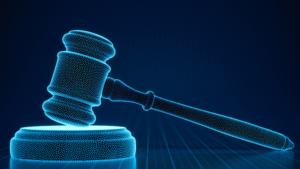Antes das informações acerca do Blockchain aplicado ao Direito serem apresentadas, é interessante explicar o que é a tecnologia. Tudo começou junto com a criptomoeda bitcoin, que é basicamente uma rede que funciona como uma cadeia de blocos, uma tecnologia de registro distribuído que visa a descentralização como medida de segurança.
Essa rede de blocos encadeados carregam o conteúdo junto a uma espécie de impressão digital e o bloco seguinte conterá a impressão do bloco anterior e assim sucessivamente onde cada bloco irá gerar sua própria impressão digital que será o resultado da junção das anteriores, também vale lembrar que qualquer alteração consegue ser identificada.
Para resumir: é basicamente um banco de dados que contém todas as transações que são executadas em determinada rede e esse banco é distribuído e compartilhado tendo a função de criar um índice global para todas as transações que ocorrem em determinado mercado. Tudo isso tem servido de inspiração para a criação de novas criptomoedas e bancos de dados distribuídos.
Mas como isso pode ser aplicado ao Direito?
Uma aplicação interessante de blockchain é a utilização da tecnologia para autenticar documentos que hoje são realizados pelos cartórios, vale lembrar que isso não exclui a necessidade cartórios, seria mais uma ferramenta que traria benefícios. Registrar em blockchain significa verificar a autenticidade de documentos digitais, contratos e identidade de pessoas de maneira segura, eficiente e mais rápida.
Também é possível realizar contratos eletrônicos, onde, pelo processamento de dados, o contrato pode se executar sozinho de acordo com a vontade das partes. quando um contrato é firmado por um software de automação baseado em blockchain os dados das partes e da locação são preenchidos de forma automática.
Além disso é possível realizar registro de dados para escritórios e empresas, registro de provas de autoria e muito mais.
Esse um tema que será muito discutido nos próximos anos, pois só tende a evoluir com o passar do tempo. Ainda não é possível identificar até onde essa tecnologia poderá chegar.





